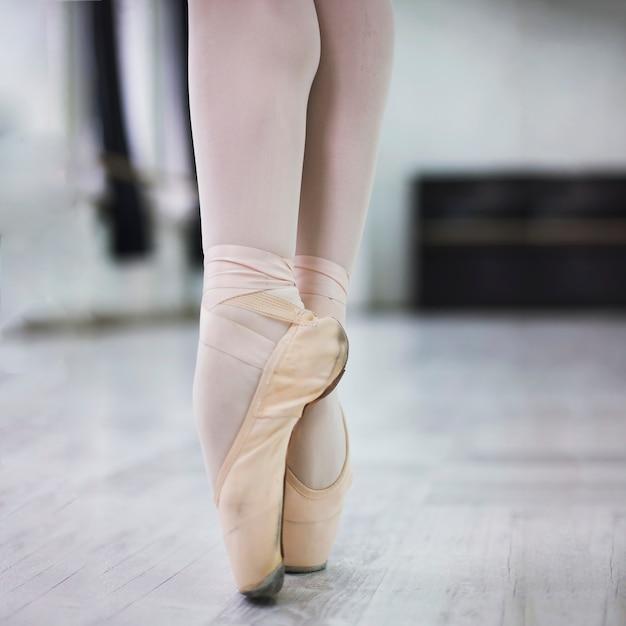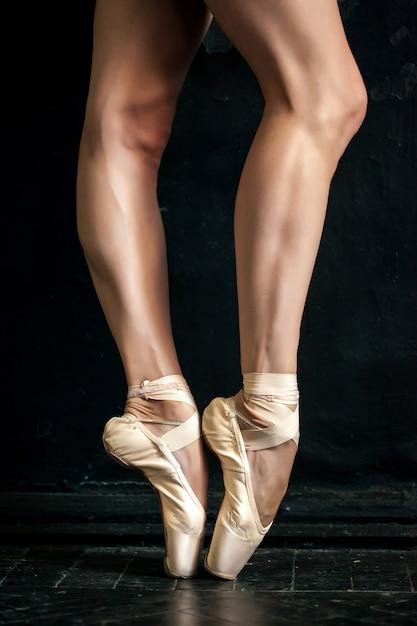Are you captivated when you see a dancer gracefully gliding across the stage, seemingly defying gravity with their every move? Have you ever wondered what it is about dancers that gives them those oh-so-enviable legs? Well, wonder no more! In this blog post, we’re going to delve deep into the world of dance to uncover the secrets behind those beautifully toned dancer’s legs.
From ballet to hip-hop, dancers come in all shapes and sizes, but there’s something undeniably special about their legs. But why is that? Do dancers have naturally thick legs, or is it something they work hard to achieve? And what exactly does having a “dancer’s body” even mean? Join us as we explore these questions and more, and discover what it takes to get those covetable dancer’s legs.
Whether you’re a fellow dancer looking to understand your body better or simply someone who appreciates the artistry of dance, this blog post will provide you with insights, explanations, and maybe even a few surprises. So put on your dancing shoes and get ready to learn what it truly means to have dancer’s legs!

What Does Dancer’s Legs Mean
Have you ever wondered what it means to have “dancer’s legs”? Well, get ready to pirouette into the world of dance and find out! Dancer’s legs are often associated with grace, strength, and flexibility, but there’s so much more to it than meets the eye.
The Perfect Blend of Power and Elegance
When it comes to dancer’s legs, think of them as the ultimate combination of power and elegance. These legs have been sculpted through countless hours of hard work and dedication, both in the studio and on the stage. They’re not just toned and lean, but they also possess a certain fluidity that is unmatched.
The Leg Muscles That Make It Happen
To understand dancer’s legs, let’s take a closer look at the key muscles involved. The quadriceps (front of the thigh) are responsible for powerful jumps and leg extensions. The hamstrings (back of the thigh) provide control and stability during intricate movements. The calves (lower leg) give that extra spring in each step. And let’s not forget about the glutes (yes, the booty!) that offer stability and power to every movement.
A Balance Between Strength and Flexibility
Dancers are known for their incredible flexibility, and their legs play a significant role in achieving those extraordinary stretches and extensions. But it’s not just about being flexible; dancers also need a great deal of strength to execute their movements with control and precision. So, dancer’s legs are like the perfect harmony between strength and flexibility, allowing dancers to perform those gravity-defying moves effortlessly.
No Pain, No Gain
While dancer’s legs may look effortlessly beautiful, let’s not forget the blood, sweat, and tears that go into achieving them. Dancers push their bodies to the limit, enduring countless blisters, sore muscles, and sometimes even injuries. It’s an art form that demands sacrifices, but the results are undeniably stunning.
Confidence and Grace that Transcends Dance Floors
Beyond the physical attributes, dancer’s legs also represent confidence and grace. Dancers possess an innate ability to command attention with their every move. Whether it’s on a grand stage or a crowded dance floor, those legs speak volumes, exuding a magnetic energy that captivates audiences and inspires admiration.
Take a Leap and Embrace Your Inner Dancer
So, now that you know what dancer’s legs mean, it’s time for you to unleash your inner dancer! You don’t have to be a professional to experience the joy and benefits of dance. Whether it’s ballet, hip hop, salsa, or even just dancing around your living room, let those legs groove to the beat and embrace the beauty of movement.
In conclusion, dancer’s legs are not just about aesthetics; they symbolize the strength, flexibility, grace, and dedication that dancers embody. So, the next time you see someone with “dancer’s legs,” remember the hard work and passion that have shaped those incredible limbs. And who knows, maybe with a little practice and a whole lot of confidence, you could be flaunting your own fabulous dancer’s legs in no time!
I hope you enjoyed this informative and entertaining exploration of dancer’s legs! Stay tuned for more fascinating insights into the world of dance and movement.

FAQ: What Does Dancer’s Legs Mean
As a dance enthusiast or someone who appreciates dancers, you might have come across the term “dancer’s legs” and wondered what exactly it means. In this FAQ-style subsection, we’ll dive into some of the most frequently asked questions about dancer’s legs, debunk a few myths, and explore what makes dancers’ legs so unique. So put on your dancing shoes, and let’s get started!
Why Do Runners Have Slim Legs
It’s no secret that runners often have slim and toned legs. The repetitive motion of running leads to the development of long, lean muscles in the legs. However, it’s important to note that not all dancers have slim legs. Dancers come in all shapes and sizes, and their leg muscles can vary depending on the dance style they practice.
Does Ballet Give You Toned Thighs
Ballet is known for its elegant and graceful movements, and yes, it can certainly help tone your thighs. Ballet involves various leg exercises such as pliés, développés, and grand battements that target and strengthen the thigh muscles. With consistent training, dancers can achieve beautifully toned thighs.
Does Dancing Make Your Breasts Smaller
While dancing is a great form of exercise, it doesn’t have a direct impact on breast size. Breasts are primarily composed of fatty tissue, and their size is determined by factors such as genetics, hormones, and weight fluctuations. So, keep dancing with confidence, knowing that your breast size won’t be affected.
Why Are Dancers So Strong
Dancers possess incredible strength due to the physical demands of their art form. Dancing requires core stability, balance, flexibility, and muscular endurance. Through hours of rigorous training, dancers develop strong and well-defined muscles throughout their bodies, including their legs.
Do Dancers Have Strong and Shapely Legs
Yes, dancers often have strong and shapely legs. The combination of training, muscular engagement, and specific dance movements helps sculpt and define the leg muscles. Dancers’ legs can range from long and slender to muscular and powerful, depending on their dance style and individual physique.
What Makes a Dancer a Dancer
To be a dancer, it takes passion, dedication, discipline, and a love for movement. Dancers express themselves through various dance styles, such as ballet, jazz, contemporary, or hip-hop. They spend countless hours in the studio perfecting their technique, working on their strength and flexibility, and dedicating themselves to the art of dance.
How Do You Get Those Enviable Dancer’s Legs
Achieving dancer’s legs is a combination of genetics, proper training, and consistency. Regular dance classes, stretching routines, and targeted exercises specific to your dance style can help develop and tone your leg muscles. Remember, it’s not just about the look of dancer’s legs; it’s about the strength and control that comes with them.
How Can I Tell If I Have a Talent for Dancing
If you have a passion for dancing and find joy in expressing yourself through movement, you could very well have a talent for dancing. Taking dance classes, exploring different dance styles, and receiving feedback from instructors can help you recognize and nurture your dancing abilities. Remember, everyone starts somewhere, so don’t be afraid to start dancing and see where it takes you!
What Does It Mean to Have a Dancer’s Body
Having a dancer’s body typically refers to a physique that is lean, toned, and flexible. Dancers strive for a strong core, a lengthened posture, and well-defined muscles throughout their bodies. However, it’s essential to embrace and celebrate all body types, as dancers come in a wide range of shapes, sizes, and proportions.
What Makes the Perfect Dancer Body
The beauty of dance lies in its diversity, and there is no one “perfect” dancer body. Different dance styles require different physical attributes. For ballet, long lines and flexibility are emphasized, while hip-hop may focus on strength and agility. Ultimately, the perfect dancer body is one that allows the dancer to express themselves fully and passionately through movement.
Does Dancing Help Tone Your Legs
Yes, dancing is a fantastic way to tone your legs. The dynamic movements in dance engage various muscles in the legs, including the quadriceps, hamstrings, calves, and glutes. So next time you hit the dance floor, know that you’re not only having fun but also giving your legs a great workout.
Does Twerking Tone Your Thighs
Twerking, a dance move that involves rhythmic hip thrusts and isolations, primarily targets the gluteus maximus, rather than the thighs. However, the movements and squats involved in twerking can provide a good lower body workout, helping strengthen and tone the muscles in your thighs as well.
Why Do Dancers Have Such Amazing Bodies
Dancers have incredibly fit and toned bodies because dance itself is a demanding physical activity. The combination of cardiovascular endurance, strength training, flexibility, and meticulous technique training shapes and sculpts the bodies of dancers. So, in addition to their talent and artistry, dancers also benefit from the rewarding physical aspect of their craft.
Why Do Dancers Have Slim Legs
Dancers don’t necessarily have universally slim legs. The appearance of a dancer’s legs can vary depending on the dance style they practice and their own individual body type. Some dancers may have naturally slim legs, while others may have more muscular or athletic-looking legs. However, dancers often have well-defined leg muscles due to the intense training they undergo.
Why Are Dancers So Beautiful
The beauty of dancers goes beyond their physical appearance. Dancers exude grace, poise, and passion through their movements, captivating audiences with their storytelling abilities. A combination of talent, dedication, and the joy of dancing contributes to the innate beauty that shines through dancers.
How Do Dancers Stay So Lean
Dancers stay lean through a combination of regular dance training, mindful nutrition, and a healthy lifestyle. The physical demands of dance, coupled with a balanced diet, help dancers maintain their leanness. However, it’s important to note that each dancer’s body is unique, and the pursuit of leanness should always be approached with care and respect for individual health and well-being.
How Can You Identify a Natural Dancer
Identifying a natural dancer can be subjective, but several factors may indicate natural talent. Natural dancers often possess an innate sense of rhythm, musicality, coordination, and an ability to pick up choreography quickly. They may also exhibit a sense of ease and expressiveness in their movements, captivating audiences effortlessly.
Why Is Ballet Considered Beautiful
Ballet is considered beautiful because of its stunning combination of grace, precision, strength, and storytelling. The fluidity and elegance of ballet movements, coupled with the exquisite costumes, music, and stagecraft, create a captivating visual and emotional experience for both the dancers and the audience. Ballet embodies the essence of beauty through movement.
Can Dancing Help Slim Legs
Yes, dancing can contribute to slimming and toning your legs. The dynamic and varied movements in dance, combined with the calorie-burning nature of cardiovascular exercise, can help reduce body fat and shape the muscles in your legs. So shake those legs on the dance floor and enjoy the benefits of a fun and effective leg workout!
Remember, dancer’s legs come in all shapes and sizes, reflecting the diversity and artistry of the dance world. Whether they’re slim, muscular, or somewhere in between, dancer’s legs are a testament to the dedication, skill, and passion that dancers bring to their craft. So keep dancing, keep celebrating your unique body, and never stop chasing the joy that dance brings.